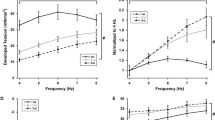Summary
A reportedly new technique for excitation-contraction uncoupling of frog skeletal muscle fibres was evaluated by low-frequency linear cable analysis and electron microscopy. Results indicate a similarity between the electrophysiological and ultrastructural effects of the formamide procedure and those obtained with conventional glycerol shock. Fibres in isolated frog sartorius muscles immersed in a frog Ringer's-formamide solution showed a rapid decline in twitch tension and a decrease in specific membrane capacitance, and disruption of the morphology of the transverse tubule system. These results are consistent with physical and electrical isolation of the transverse tubular network from the surface membrane of the muscle fibre (‘detubulation’). However, reduction of twitch tension is marked in the formamide solution. Complete paralysis is only achieved following the return to normal Ringer's. Probably due to the greater membrane permeability of formamide, the technique requires less time and may be more reliable than the standard glycerol shock procedure.
Similar content being viewed by others
References
CORDOBA, F., SCHOOF, S., VELEZ, S. & DELCASTILLO, J. (1968) Inhibitory action of formamide on smooth muscle contraction.Life Sci. 7, 897–903.
COSTANTIN, L. L. (1977) Activation in striated muscle. InHandbook of Physiology — The Nervous System I (edited by KANDEL, E.), pp. 00-00. Bethesda, Maryland: American Physiological Society.
DEL CASTILLO, J. & ESCALONA DE MOTTA, G. (1978) A new method for excitation-contraction uncoupling in frog skeletal muscle.J. Cell Biol. 78, 782.
DULHUNTY, A. F. & GAGE, P. W. (1973) Differential effects of glycerol treatment on membrane capacity and excitation-contraction coupling in toad sartorius fibres.J. Physiol. 234, 373–408.
EISENBERG, B. & EISENBERG, R. S. (1968) Selective disruption of the sarcotubular system in frog sartorius muscle: a quantitative study with exogenous peroxidase as a marker.J. Cell Biol. 39, 451–67.
FRANZINI-ARMSTRONG, C. (1964) Fine structure of sarcoplasmic reticulum and transverse tubular system in muscle fibers.Fed. Proc. 23, 887–95.
FRANZINI-ARMSTRONG, C., VENOSA, R. H. & HOROWICZ, P. (1973) Morphology and accessibility of the ‘transverse’ tubular system in frog sartorius muscle after glycerol treatment.J. membr. Biol. 14, 197–212.
GAGE, P. W. & EISENBERG, R. S. (1969a) Capacitance of the surface and transverse tubular membrane of frog sartorius muscle fibers.J. gen. Physiol. 53, 265–77.
GAGE, P. W. & EISENBERG, R. S. (1969b) Action potentials, after potentials and excitation-contraction coupling in frog sartorius fibers without transverse tubules.J. gen. Physiol. 53, 298–310.
GORDON, A. M. & GODT, R. E. (1970) Some effects of hypertonic solutions on contraction and excitation-contraction coupling in frog skeletal muscles.J. gen. Physiol. 55, 254–75.
GORDON, A. M., HUXLEY, A. F. & JULIAN, F. (1966) Tension development in highly stretched vertebrate muscle fibres.J. Physiol. 184, 153–69.
HODGKIN, A. L. & HOROWICZ, P. (1957) The differential action of hypertonic solutions on the twitch and action protential of a muscle fibre.J. Physiol. 136, 17–18.
HODGKIN, A. L. & NAKAJIMA, S. (1972) Analysis of the membrane capacity in frog muscle.J. Physiol. 221, 121–36.
HODGKIN, A. L. & RUSHTON, W. A. H. (1946) The electrical constants of a crustacean nerve fibre.Proc. R. Soc.,133, 444–79.
HOWELL, J. N. & JENDEN, D. J. (1967) T-tubules of skeletal muscle: morphological alterations which interrupt excitation-contraction coupling.Fed. Proc. 26, 553.
KAMINER, B. (1960) Effect of heavy water on different types of muscle and on glycerol-extracted psoas fibres.Nature 185, 172–3.
KROLENKO, S. A. (1971) Effect of fluxes of sugars and mineral ions on the light microscopic structure of frog fast muscle fibres.Nature 229, 424.
KROLENKO, S. A., ADAMJAN, S. J. & SHWINKA, N. E. (1961) Vacuolization of skeletal muscle fibres after discharging low-molecular non-electrolytes.Cytology (U.S.S.R.),9, 1346–53.
SEVCIK, C. & NARAHASHI, T. (1972) Electrical properties and excitation-contraction uncoupling in skeletal muscle treated with ethylene glycol.J. gen. Physiol. 60, 221–36.
Author information
Authors and Affiliations
Rights and permissions
About this article
Cite this article
Argiro, V. Excitation-contraction uncoupling of striated muscle fibres by formamide treatment: evidence of detubulation. J Muscle Res Cell Motil 2, 283–294 (1981). https://doi.org/10.1007/BF00713267
Received:
Issue Date:
DOI: https://doi.org/10.1007/BF00713267




